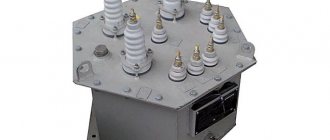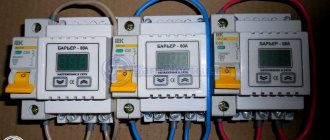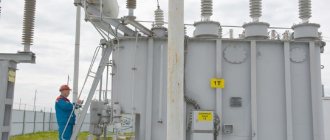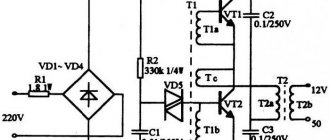Voltage transformer working principle
For direct connection to high voltage, very bulky devices and relays would be required due to the need to make them with high-voltage insulation. The manufacture and use of such equipment is practically impossible, especially at voltages of 35 kV and above.
The use of voltage transformers allows the use of standard measuring instruments for high voltage measurements, expanding their measurement limits; relay windings connected via voltage transformers can also have standard designs.
In addition, the voltage transformer isolates (separates) the meters and relays from high voltage, making them safe to operate in the substation.
The main fundamental difference between measuring voltage transformers (VT) and current transformers (CT) is that they, like all power models, are designed for normal operation without a short-circuited secondary winding.
At the same time, if power transformers are designed to transmit transported power with minimal losses, then voltage instrument transformers are designed for the purpose of highly accurate repetition on the scale of primary voltage vectors.
voltage transformer
Principles of operation of a voltage transformer
The design of a voltage transformer, like a current transformer, can be represented by a magnetic core with two windings wound around it:
- primary;
- secondary.
Special grades of steel for the magnetic core, as well as the metal of their windings and the insulation layer are selected for the most accurate voltage conversion with the least loss. The number of turns of the primary and secondary coils is calculated in such a way that the nominal value of the high-voltage line voltage of the network supplied to the primary winding is always reproduced by the secondary value of 100 volts with the same vector direction for systems assembled with a grounded neutral.
If the primary energy transfer circuit is created with an isolated neutral, then 100/√3 volts will be present at the output of the measuring winding.
To create different ways of simulating primary voltages, not one, but several secondary windings can be located on the magnetic core.
Lightning protection
To perform lightning protection of a transformer substation with a metal roof, it is necessary to connect the roof to an external ground loop.
The connection occurs at two opposite points. That is, at one point the roof is connected to the external contour, and from the opposite side, the roof is also connected to the contour. The connecting conductor becomes a wire 8 mm thick.
If the roof is not metal, then a special lightning rod is created on top of it.
Decoding and markings
To distinguish between types of models, letter markings are used:
N – voltage transformer; T – three-phase model; O – single-phase TN; C – dry (air cooling); M – oil; A – anti-resonance models; K – cascade devices; F – porcelain body type; I – five-rod transformer containing a winding for insulation control; L – designs in a cast body; DE – capacitive; G – grounded (the primary coil must be grounded).
Technical specifications
Technical parameters of transformers:
voltage value at the primary phase input; voltage at the terminals of the secondary phase windings; power factors; maximum short circuit voltages. Important information includes the parameters of the rated frequency and the accuracy class for the rated transformation ratio. On some models, manufacturers indicate angular errors and permissible voltage errors.
Basic information is indicated on the voltage transformer nameplate.
Single-phase voltage transformer device
single-phase voltage transformer device
Single-phase voltage transformer device:
- a - general view of the voltage transformer;
- b - removable part;
- 1.5 - bushings;
- 2 — bolt for grounding;
- 3 - drain plug;
- 4 - tank;
- 6 - winding;
- 7 - core;
- 8 — screw plug;
- 9 - high-voltage input contact
Single-phase voltage transformers are most widespread. They are produced for operating voltages from 380 V to 500 kV.
The design dimensions and weight of a voltage transformer are determined not by power, as with power transformers, but mainly by the volume of insulation of the primary winding and the dimensions of its high voltage terminals.
Voltage transformers with rated voltages from 380 V to 6 kV are designed with dry insulation (the windings are made of PEL wire and impregnated with asphalt varnish).
The Sverdlovsk Current Transformer Plant produces voltage transformers for 6, 10, 35 kV with cast insulation.
Transformers with voltages of 10 - 500 kV have oil insulation (the magnetic circuit is immersed in transformer oil).
An example of the purpose and scope of application of voltage transformers ZNOL-NTZ
Transformers are designed for outdoor installation in open switchgears (OSD). Transformers provide signal transmission of measuring information to measuring instruments, protection and control devices, and are intended for use in commercial electricity metering circuits in AC electrical installations for a voltage class of 35 kV. Transformers are made in the form of a supporting structure.
The transformer housing is made of a compound based on the hydrophobic cycloaliphatic resin “Huntsman”, which at the same time serves as the main insulation and protects the windings from mechanical and climatic influences. The operating position of the transformers in space is vertical, with high-voltage leads up.
circuit diagram for switching on the windings of the ZNOL-NTZ voltage transformer
- See ZNOL transformers, characteristics diagrams in the table
Voltage transformer connection diagrams
Instrument transformers are used to measure linear and/or phase primary quantities. To do this, the power windings are connected between:
- line wires to control line voltages;
- bus or wire and ground to read the phase value.
An important safety element for voltage instrument transformers is the grounding of their housing and secondary winding.
Increased attention is paid to the grounding of voltage transformers, because if the insulation of the primary winding breaks down on the housing or in the secondary circuits, a high-voltage potential will appear in them, which can injure people and burn equipment.
Intentional grounding of the housing and one secondary winding diverts this dangerous potential to the ground, thereby preventing further development of the accident.
The simplest connection diagram is used at service points for lines under voltage of 6 - 10 kV. Transformers connected in this way are used to turn on the voltmeter and supply voltage to the relay of the ATS device.
An example of such a circuit is shown in Fig. 7.
Rice. 7. Simple voltage transformer connection diagram
Figure 8 shows a circuit used to switch on single-phase transformers to supply safe voltage to loads powered from the secondary windings. This circuit uses a group of single-phase transformers, the coils of which are connected according to the star principle. Please note that the primary windings are connected to a solidly grounded neutral.
Rice. 8. Another example of a connection diagram
This scheme is used in 0.5 – 10 kV networks for connecting measuring instruments and meters. Voltmeters used to monitor insulation are connected using a similar circuit.
The circuit is effective for receiving signals indicating single-phase ground faults. There are other connection schemes, in particular according to the open delta connection type. The peculiarity of such schemes is that the power of a group of two VTs is less than the power of three devices connected in a full triangle circuit not by 1.5 times, but by √3 times.
Some circuits use a combined connection of windings. A delta-star connection is suitable for this purpose. In the operation of such circuits, the rated voltage is 173 V. The specified connection method is used in systems for regulating the excitation of generator and compensator windings.
Creating an Outer Path
To make the external grounding loop of the transformer, vertical electrodes connected by horizontal jumpers are used. The jumpers are made of sheet steel 4 mm thick and 40 mm wide. The electrodes are stuck into the ground around the perimeter of the transformer.
Check the soil resistivity. It should be a maximum of 100 Ohm*m. Based on this, it is required to create a circuit with a maximum resistance of 4 ohms.
If you take a circle with a diameter of 16 m, with a conditional transformer in the middle, then to create a grounding loop you will need at least eight electrodes, each 5 m long.
They are placed at a distance of approximately 1 m from the foundation of the transformer station. The closer the rods are to the wall, the better. Horizontal joint strips are laid on the edge to a depth of 0.5-0.7 m.
This location requirement is related to security issues. The ground electrode must not be damaged during any repair or construction work.
Voltage transformer for voltages up to 35 kV
A voltage transformer for voltages up to 35 kV is no different in principle from a power step-down transformer. It consists of a magnetic circuit made of electrical steel sheet plates, a primary winding and one or two secondary windings. In Fig. 2.1. shows a diagram of a voltage transformer with one secondary winding. A high voltage Ub is applied to the primary winding and the voltage of the secondary winding U2 is connected to the measuring device.
rice. 2.1 Connection diagram for a single-phase voltage transformer
Transformers are used in outdoor (type NOM-35, ZNOM and NKF series) or indoor AC installations with a voltage of 0.38-500 kV and a nominal frequency of 50 Hz. Three-winding transformers NTMI are designed for networks with an isolated neutral, NKF series (except NKF-110-5 - with a grounded neutral.
Three-winding transformers NTMI are designed for networks with an isolated neutral, NKF series (except NKF-110-5 - with a grounded neutral.
Single-phase, three-phase (five-leg) and cascade voltage transformers (VTs) are used in electrical installations. The choice of one or another type of voltage transformer depends on the network voltage, the value and nature of the load of the secondary circuits and the purpose of the voltage transformer (for modification purposes, for monitoring single-phase ground faults, for powering relay protection and automation devices).
Due to the relatively high cost of voltage transformers for 110-750 kV networks, in a number of cases, where this is possible under the operating conditions of measurement, protection and automation systems of electrical installations, they are replaced with capacitive voltage dividers.
Based on insulation, voltage transformers are divided into dry and oil insulated.
Designation of the voltage transformer in the diagram
Designation of a voltage transformer in the diagram
Transformer fuses protect voltage transformers from damage in the event of their operation in abnormal mode - in the event of a single-phase ground fault, in the event of ferroresonance phenomena occurring in the network, or in the event of a short circuit in the primary winding of the voltage transformer.
Operating principle
The action of electromagnetic sweat of a transformer
The principle of operation of a single-phase transformer is based on the law according to which the alternating electromagnetic field acting in a turn induces an emf in a nearby conductor. The phenomenon is called Faraday's law of electromagnetic induction, who was the first to discover this interesting effect. To substantiate it, the scientist developed an entire theory, which formed the basis for the operation of most modern electrical devices and units.
Its main provisions:
- when current passes through a coil of wire, a magnetic flux is formed around it, capturing all the same coils located nearby;
- under the influence of this flow, an EMF is induced in them, the shape of the changes coinciding with the original field;
- If there is a ferromagnet in it, this effect is enhanced.
All these principles form the basis of the operation of a modern transformer product. When connected to the secondary winding of the load, the operating circuit is closed, and the energy is transferred to the consumer with virtually no losses.
Three-phase transformer
Among the electromagnetic devices of this type, the three-phase transformer stands out. It has magnetic and galvanic phase connections. The presence of a circuit of the first type is due to the connection of magnetic circuits into one system. In this case, the magnetic fluxes are located relative to each other at an angle of 120 °. A rod is not needed in this system, since when the centers of the three phases are combined, the sum of the electromagnetic channels is equal to zero, regardless of time. Thanks to this, a circuit with six rods is converted into a three-rod one.
Three types of circuits can be used to connect the windings of the device:
- A star connection can be made with or without output from common points. Here each winding is connected to a neutral point.
- According to a triangular diagram, the phases are connected in series.
- Zigzag is a pattern that is most often used during retraction from a common point. It connects three windings located on different magnetic cores.
The use of a three-phase transformer is more economical than the use of connected single-phase structures.
Voltage transformer load
The secondary load of the voltage transformer is the power of the external secondary circuit. The rated secondary load is understood as the highest load at which the error does not exceed the permissible limits established for transformers of a given accuracy class.
Voltage transformer designs
In installations with voltages up to 18 kV, three-phase and single-phase transformers are used; at higher voltages, only single-phase transformers are used.
At voltages up to 20 kV there are a large number of types of voltage transformers: dry (NOS), oil (NOM, ZNOM, NTMI , NTMK), with cast insulation ( ZNOL ). It is necessary to distinguish single-phase two-winding transformers NOM from single-phase three-winding transformers ZNOM. Transformers of types ZNOM-15, -20 -24 and ZNOL-06 are installed in complete conductors of powerful generators. In installations with voltages of 110 kV and higher, cascade-type voltage transformers NKF and capacitive voltage dividers NDE are used.
Voltage transformers
Instrument voltage transformers are designed to reduce primary voltages to values that are most convenient for connecting measuring instruments, protection relays, and automation devices. The use of instrument transformers ensures the safety of workers, since the high and low voltage circuits are separated, and also makes it possible to unify the design of devices and relays.
What is the difference between a current transformer and a voltage transformer?
By definition, these devices are designed to work with different electrical quantities as basic ones and, accordingly, the switching circuits will be different. For example, a current transformer is powered by a current source and does not work, and may even fail, if its windings are not loaded and no electric current flows through them. The voltage transformer is powered by voltage sources and, conversely, cannot operate for a long time in modes with high current loads
Video: Voltage Transformers
Technical characteristics of voltage transformers, connection diagrams. Factors influencing the accuracy class. Types of voltage transformers, identification of markings.
What is a voltage transformer
With isolated neutral
They are most often used in mines and in various wet areas; in any case, even with such a power supply, all current-conducting housings must be grounded. But such power systems are also equipped with special devices that control leakage current. If the insulation resistance is below a certain set value, for example, 10,000 Ohms, then the leakage relay should automatically turn off the power supply, in this case the transformer. You cannot connect any electrical appliance or device to the phase and ground loop; a shutdown will occur immediately. Also, an emergency shutdown will occur if a person comes under dangerous voltage and touches the ground, since the human resistance is from 1000 to 5000 Ohms, depending on humidity and skin;
for “What is a voltage transformer”
- Rom
:V
My car, which was imported from Canada, has a 110 V engine heater installed. The heater power is unknown. The wire cross-section is about 0.75 in appearance. I want to buy or make a transformer. If you buy, then their powers are indicated in kVA, what does this mean, please explain, popularly. Or tell me how to do it. What power do you think can be selected?
Answer
- Expert
:
V
Measure the resistance of the heater (with any Ketai multimeter). Its power will be P = U*U/R, P in watts, U in volts, R in ohms. It is better to choose a transformer with approximately one and a half margin, just in case. In addition, the actual power will be less, because When heated, the resistance will increase and the power will decrease. How difficult it is to say, depending on what the heater is made of and how hot it gets. But this can also be written off as a reserve. In the case of a purely resistive load, such as a heater, we can assume that kVA = kW.
Answer
- Rom
:
V
Thanks Expert for the clarification! The resistance was measured earlier - 35 Ohms. P=U*U/R=110*110/35=346 W*1.5 = 519 W. Those. I can take a 0.5 kVA transformer
In what case is kVA not equal to kW?
Answer
- Expert
:
V
In theory, a simple 220/110 transformer is enough. It will be cheaper and safer with it, it provides complete isolation from the network, but an autotransformer does not.
In general, kVA = kW*KM, where KM is the power factor, it ranges from 0 to 1.
For a purely active load (heater, incandescent lamp, etc.), when there is just some kind of linear resistance, KM is close to 1.
But if the load has reactance (inductance, capacitance) or nonlinearity, or even all together, then the KM can be much lower, and then the difference between kVA and kW must be taken into account. kVA is the apparent power, kW is the active power consumed.
Answer
- Admin
:
V
Through an autotransformer, your heater will be galvanically connected to the network; it does not provide isolation. And through the transformer there is complete isolation. If you are absolutely sure that the heater insulation is designed for direct connection to the network and it is in order, you can use an autotransformer. If there is no such confidence, then it is better not to take risks.
Answer
- Volodya K
:
V
In general, kVA = kW*KM, where KM is the power factor, it can range from 0 to 1. For a purely active load (heater, incandescent lamp, etc.), when there is just some kind of linear resistance, KM is close to 1.
But if the load has reactance (inductance, capacitance) or nonlinearity, or even all together, then the KM can be much lower, and then the difference between kVA and kW must be taken into account. kVA is the apparent power, kW is the active power consumed.
Answer
- Elka
:
V
There is not enough brains or knowledge (or both) to understand why some current transformers and voltage transformers, seemingly of the same design, behave completely differently in operation.
Answer
- Denos Fox
:
V
The voltage transformer is powered by voltage. T E the primary winding will have a number of turns and a cross-section in accordance with the voltage. The current transformer is powered by the current generated in the conductor. That is, the primary winding will receive voltage from the current in the conductor. And this current will create a voltage in the primary winding.
Answer
- Elka
:
V
Denos Fox, thanks, but I still don't get it.
The purpose of the current transformer is clear to me - in order to measure a large current, it is necessary to first reduce the current strength to values acceptable for measurement by instruments, so as not to burn these instruments. But how it works is unclear. After all, if the voltage of the secondary winding of a CT reaches several thousand volts, when this winding is short-circuited, a gigantic current should flow through it, which, firstly, should burn the secondary winding with the measuring instruments connected to it, and secondly, lead to a sharp increase current of the primary winding with consumers connected to it.
They tried to explain to me that the current transformer is a step-up trans, so we get less current on the secondary winding, despite the higher voltage. But I still didn't understand the point.
Let's consider two cases:
Design differences between current and voltage transformers
In the first case, we connected the load to the step-down trance winding at a voltage of 220V, in the second, we connected the same load to the step-up trance winding at a voltage of 110,000V. But this does not mean that in the second case less current will flow through the load! Reducing the current with increasing voltage, in theory, only works if the power of the end consumer is constant, as in the very first example from the first post, when we transferred the current through a chain of trans to a consumer connected to a constant (in magnitude) voltage - 220V .
In the second example, we connect the load to different voltages, and the higher this voltage, the greater the current through the load will be, while the current in the lower voltage winding will still be greater than the current in the higher voltage winding. So why, in the case of a current transformer, does increasing the voltage on the secondary winding, to which the measuring instruments are connected, lead to a decrease in the current in it?
Answer
- Vovan
:
V
In a current transformer, the primary winding current does not depend on the secondary current.
Answer
- Petrovich
:
V
Will a 110V transformer withstand 220V? Those. at the output will we get double the voltage or will the primary winding just burn out?
Answer
- Vector
:
V
and if you apply 220 to the primary through a diode (it seems like just half will remain)
Answer
- Lech
:
V
Try turning on the Ilyich light bulb at 220 and see the result. Those who like assholes get it, they bring it, and then... Damn it, it's extreme.
Answer
- Sava
:
V
I just tried to connect 220 V to the primary trans (220 V) through a diode, like 1 half-wave (the LN through the diode burns at full intensity, that’s for sure) and the transformer, whether with or without a diode, produces the same number of volts. The output sine wave is approximately the same, not cut (tried with and without load)
Answer
- Gray P
:
V
But what are the real differences between the windings of transformers for different voltages - do they change the thickness of the varnish coating? If you measure the insulation resistance with a megohmmeter, this can show how much the transformer is designed for? For example, if you find a transformer without labels, how can you find out how much it is designed for?
Answer











